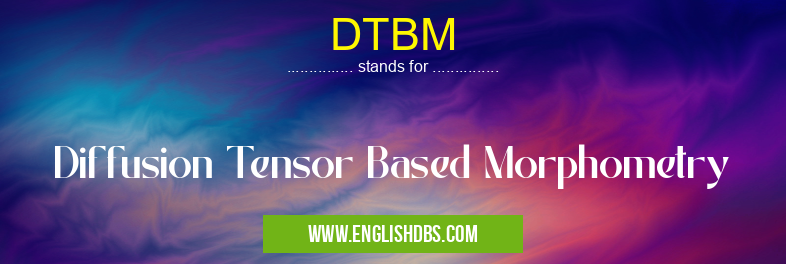What does DTBM mean in UNCLASSIFIED
DTBM stands for Diffusion Tensor Based Morphometry, a technique used to evaluate the structural integrity of white matter tracts in the brain. It involves measuring the diffusion of water molecules within the white matter, which can provide insights into the organization and health of these neural pathways.

DTBM meaning in Unclassified in Miscellaneous
DTBM mostly used in an acronym Unclassified in Category Miscellaneous that means Diffusion Tensor Based Morphometry
Shorthand: DTBM,
Full Form: Diffusion Tensor Based Morphometry
For more information of "Diffusion Tensor Based Morphometry", see the section below.
Principle of DTBM
DTBM relies on diffusion tensor imaging (DTI), a magnetic resonance imaging (MRI) technique that captures the directional diffusion of water molecules in tissues. White matter tracts are characterized by highly aligned bundles of nerve fibers, which restrict the movement of water molecules in specific directions. By measuring the diffusion tensor, DTBM can quantify the fractional anisotropy (FA) and mean diffusivity (MD) of water in each voxel.
Parameters Measured by DTBM
- Fractional Anisotropy (FA): A measure of the degree of diffusion anisotropy, which reflects the coherence of fiber orientation within a voxel. Higher FA values indicate more organized and intact white matter tracts.
- Mean Diffusivity (MD): A measure of the average diffusion of water molecules in all directions within a voxel. Higher MD values can indicate increased tissue damage or disruption of fiber integrity.
Applications of DTBM
DTBM has been widely used in neuroimaging research and clinical applications, including:
- Studying white matter development and aging
- Detecting and characterizing white matter abnormalities in neurological disorders such as multiple sclerosis, traumatic brain injury, and stroke
- Investigating the relationship between white matter integrity and cognitive function
- Assessing the effects of interventions or treatments on white matter health
Essential Questions and Answers on Diffusion Tensor Based Morphometry in "MISCELLANEOUS»UNFILED"
What is Diffusion Tensor Based Morphometry (DTBM)?
DTBM is a neuroimaging technique that uses diffusion tensor imaging (DTI) to measure the structural integrity of white matter tracts in the brain. DTI is a type of magnetic resonance imaging (MRI) that can measure the diffusion of water molecules in the brain. By analyzing the diffusion patterns, DTBM can provide information about the microstructure of white matter, including the density, orientation, and integrity of nerve fibers.
What are the applications of DTBM?
DTBM has a wide range of applications in neuroscience and clinical research. It is commonly used to:
- Study the development and aging of the brain
- Investigate the neural basis of neurological and psychiatric disorders
- Evaluate the effects of brain injuries and diseases
- Monitor the response to treatment interventions
How is DTBM performed?
DTBM involves the following steps:
- Data acquisition: DTI data is acquired using an MRI scanner. The MRI scanner generates a series of images that show the diffusion of water molecules in the brain.
- Image processing: The DTI images are processed to extract the diffusion tensor, which contains information about the direction and magnitude of water diffusion.
- Tractography: Tractography algorithms are used to reconstruct the white matter tracts in the brain based on the diffusion tensor data.
- Morphometric analysis: Various morphometric measures, such as fractional anisotropy (FA) and mean diffusivity (MD), are calculated to quantify the structural integrity of the white matter tracts.
What are the advantages of DTBM?
DTBM offers several advantages over other neuroimaging techniques:
- Non-invasive: DTBM is a non-invasive technique that does not involve the use of radiation or contrast agents.
- High resolution: DTBM provides high-resolution images of the white matter tracts in the brain.
- Sensitive to microstructural changes: DTBM is sensitive to subtle changes in the microstructure of white matter, making it a valuable tool for studying brain development, aging, and disease.
Final Words: DTBM is a valuable tool for investigating the structural integrity of white matter tracts in the brain. By measuring diffusion parameters, DTBM provides insights into the organization and health of these neural pathways, aiding in the diagnosis, understanding, and monitoring of various neurological conditions.
